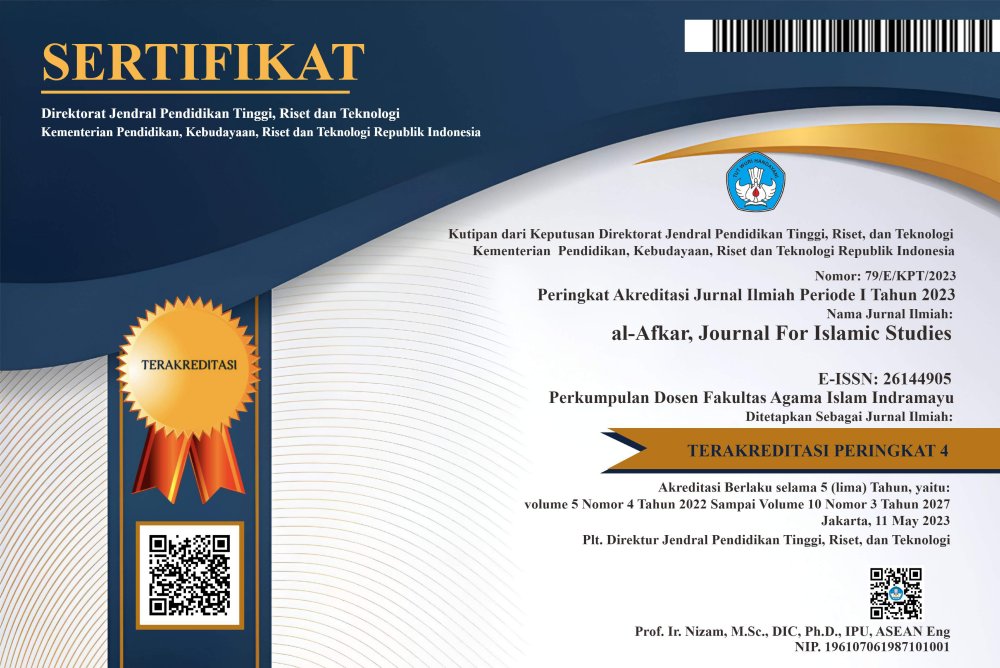Classroom Action Research: An Analysis of the Implementation of the Insani Method in Elementary Schools
DOI:
https://doi.org/10.31943/afkarjournal.v8i1.1704Keywords:
Insani Method, Optimizing Quran Reading Ability, Elementary School Religious EducationAbstract
Learning methods play a role in creating an effective and efficient learning environment that supports the achievement of optimal learning outcomes. Among the methods that can improve the ability to read the Quran is the insani method. The purpose of this study is to analyze the use of the insani method in teaching the Quran to elementary school students. This research uses a Classroom Action Research approach with participant type. The research location was an elementary school in Solok Regency, Indonesia. The informants of this study consisted of teachers and 16 elementary school students. Data collection techniques used observation, and tests. The data analysis technique uses a reduction composed of four steps, namely the planning stage, the implementation stage, the observation, and the reflection stage. The presentation of data in the form of narratives, tables, and histograms. Conclusions were obtained from interpreting data obtained from test results and observations. The insani method is proven to be able to improve student learning outcomes in reading the Quran fluently and mastering tajweed in elementary school students. This can be seen from the achievement of learner learning outcomes that increased from the first cycle of 37% of students who were complete to 88% in cycle II. This achievement has implications for the choice of teacher methods in teaching the Quran to students in elementary schools, especially in learning Islamic Religious Education.
Downloads
References
Adel, Samiullah, Nurhayati Nurhayati, Endra Endra, Ardi Satrial, and Nurainiah Nurainiah. 2024. “Islamic Religious Education Learning Innovation Using the Course Review Horay Model.” International Journal of Islamic Teaching and Learning 1(1):1–6.
Alsokari, Tareq, Nada Rahmatika, Dewi Herawati, Kardinal Kardinal, and Yumna Yumna. 2024. “Classroom Action Research: Implementasi Model Picture and Picture in Social Learning in Elementary Schools.” International Journal of Elementary School 1(1 SE-Articles):1–7. doi: 10.69637/ijes.v1i1.24.
Annuri, H. Ahmad. 2020. Panduan Tahsin Tilawah Al-Qur’an & Ilmu Tajwid. Pustaka Al-Kautsar.
Anshori, Ulumul Qur’an. 2013. “Kaidah-Kaidah Memahami Firman Tuhan.” Jakarta: Rajawali Pers.
Arikunto, Suharsimi. 2021. Penelitian Tindakan Kelas: Edisi Revisi. Bumi Aksara.
Delviany, Venny, Risnawati Risnawati, Miftahir Rizqa, Rifdah Sabrina, and Ardi Satrial. 2024. “The Relationship between Disciplinary Behavior and Religious Habits on the Religious Character of Students in High School.” International Journal of Multidisciplinary Research of Higher Education (IJMURHICA) 7(1):44–55.
Fitriani, Della Indah, and Fitroh Hayati. 2020. “Penerapan Metode Tahsin Untuk Meningkatkan Kemampuan Membaca Al-Qur’an Siswa Sekolah Menengah Atas.” Jurnal Pendidikan Islam Indonesia 5(1):15–30.
Hamidi, Farideh, Zohreh Bagherzadeh, and Sobhan Gafarzadeh. 2010. “The Role of Islamic Education in Mental Health.” Procedia - Social and Behavioral Sciences 5:1991–96. doi: https://doi.org/10.1016/j.sbspro.2010.07.402.
Hashim, Azmil, Jahidih Saili, and Mohd Aderi Che Noh. 2015. “The Relationship between Pedagogical Content Knowledge and Al-Quran Tajweed Performance among Students KKQ in Malaysia.” Procedia - Social and Behavioral Sciences 197:1530–37. doi: https://doi.org/10.1016/j.sbspro.2015.07.106.
Hassan, Surul Shahbudin Bin, and Muhammad Azhar Bin Zailaini. 2013a. “Analysis of Tajweed Errors in Quranic Recitation.” Procedia - Social and Behavioral Sciences 103:136–45. doi: https://doi.org/10.1016/j.sbspro.2013.10.318.
Hassan, Surul Shahbudin Bin, and Muhammad Azhar Bin Zailaini. 2013b. “Khatam Al-Quran in Islamic Education Curriculum in Malaysia.” Procedia - Social and Behavioral Sciences 103:558–66. doi: https://doi.org/10.1016/j.sbspro.2013.10.373.
Jamalinezhad, Mahdi, Seyed Mohammadreza Talakesh, and Seyed Hassan Khalifeh Soltani. 2012. “Islamic Principles and Culture Applied to Improve Life Quality in Islamic Cities.” Procedia - Social and Behavioral Sciences 35:330–34. doi: https://doi.org/10.1016/j.sbspro.2012.02.095.
Kemmis, Stephen, Robin McTaggart, and Rhonda Nixon. 2014. “The Action Research Planner: Doing Critical Participatory Action Research.”
Khasanah, Annisa Windar, Agus Muharam, and Hisny Fajrussalam. 2023. “Analisis Kemampuan Menghafal Al Quran Terhadap Hasil Belajar Siswa Kelas V Di Sekolah Dasar.” Al Qodiri: Jurnal Pendidikan, Sosial Dan Keagamaan 21(2):853–61.
Mahira, Moren, Nur Hazifa, Rosi Guspita, M. Zuhri, Muhiddinur Kamal, and Ardi Satrial. 2024. “Implementations of Character Education in Improving the Religious of High School Students.” International Journal of Islamic Thought, Research and Practice 1(1):10–19.
Mawardi, Amirah. 2023. “Membaca Al-Quran Dan Kecerdasan Spiritual: Sebuah Studi Pada Santri Pondok Pesantren Khairul Ummah Kabupaten Bantaeng.” Pilar 14(1):105–12.
Miles, Matthew B., A. Michael Huberman, Johnny Saldana. 2014. Qualitative Data Analysis a Methods Sourcebook. Third Edit. United States of America: SAGE Publications, Inc.
Mualimin, Mualimin, and Rahmat Arofah Hari Cahyadi. 2014. “Penelitian Tindakan Kelas Teori Dan Praktik.” Universitas Muhammadiyah Sidoarjo.
Muhammad Ibnu Faruk Fauzi. 2022. “PEMBINAAN AKHLAK PADA ANAK USIA DINI MELALUI METODE PEMBIASAAN DALAM PEMBELAJARAN PENDIDIKAN AGAMA ISLAM.” NUSANTARA Jurnal Pengabdian Kepada Masyarakat 2(2 SE-Articles):34–42. doi: 10.55606/nusantara.v2i2.301.
Mukhliso, Mukhliso. 2020. “Strategi Guru Pendidikan Agama Islam Untuk Menanamkan Pendidikan Karakter Religius Di Sekolah Dasar.” Jurnal Pendidikan Agama Islam Indonesia 1(1):64–68.
Mulyani, Hetty, and Maryono Maryono. 2019. “Implementasi Metode Qiroati Dalam Pembelajaran Al-Qur’an.” Paramurobi: Jurnal Pendidikan Agama Islam 2(2):25–34.
Musya’adah, Umi. 2020. “PERAN PENTING PENDIDIKAN AGAMA ISLAM DI SEKOLAH DASAR.” Aulada : Jurnal Pendidikan Dan Perkembangan Anak 2(1 SE-Articles). doi: 10.31538/aulada.v2i1.556.
Nisa, Khafiyah Muslihatun, Akhmad Mujani, and Abdul Aziz Romdhoni. 2023. “Pemberdayaan Masyarakat Dalam Meningkatkan Pemahaman Baca Al Quran Di Desa Gunungsari Kecamatan Sukagumiwang Kabupaten Indramayu.” Diplomasi: Jurnal Demokrasi, Pemerintahan Dan Pemberdayaan Masyarakat 1(1):53–59.
Palufi, Ayi Nutfi, and Ahmad Syahid. 2020. “Metode Yanbu’a Sebagai Pedoman Membaca Al-Qur’an.” Attractive : Innovative Education Journal 2(1 SE-Articles):32–40. doi: 10.51278/aj.v2i1.21.
Rauf, Al-Hafizh Abdul Aziz Abdur. 2010. Pedoman Dauroh Al Quran: Kajian Ilmu Tajwid Disusun Secara Aplikatif. Markaz Al-Quran.
Saepudin, Juju. 2019. “Pendidikan Agama Islam Pada Sekolah Berbasis Pesantren: Studi Kasus Pada SMP Al Muttaqin Kota Tasikmalaya.” EDUKASI: Jurnal Penelitian Pendidikan Agama Dan Keagamaan 17(2).
Sulaiman, M. A. 2017. “METODOLOGI PEMBELAJARAN PENDIDIKAN AGAMA ISLAM (PAI).”
Surasman, Otong. 2002. Metode Insani: Kunci Praktis Membaca Alquran Baik Dan Benar. Gema Insani.
Zheihan Aisyah Achmad, Ajat Rukajat, and Undang Ruslan Wahyudin. 2022. “PENGARUH METODE TALAQQI TERHADAP PENINGKATAN KEMAMPUAN MENGHAFAL AL-QUR’AN PESERTA DIDIK KELAS AL-QUR’AN TPQ DARUSSALAM.” Al-Afkar, Journal For Islamic Studies 5(1 SE-Articles):282–301. doi: 10.31943/afkarjournal.v5i1.230.
Zulaikhah, Siti. 2019. “Penguatan Pendidikan Karakter Melalui Pendidikan Agama Islam Di Smpn 3 Bandar Lampung.” Al-Tadzkiyyah: Jurnal Pendidikan Islam 10(1):83–93.
Downloads
Published
How to Cite
Issue
Section
License
Copyright (c) 2025 Zulmasri Zulmasri, Muhammad Kabil Ikbal, Ardi Satrial, Norman Haziq Bin Salahudin

This work is licensed under a Creative Commons Attribution 4.0 International License.



















